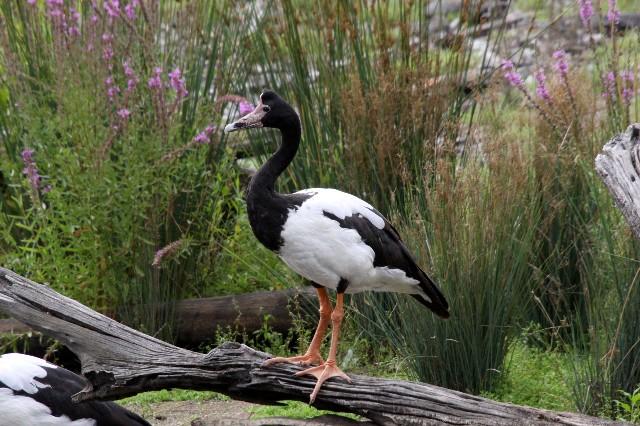
Magpie goose(Anseranas semipalmata)
Phylum —chordata
Class — aves
Order — anseriformes
Family — anseranatidae
Genus – anseranas
Appearance
Magpie geese are black on the head, neck, tail, and wings. The rest of the body is white, with orange feet and legs. Magpie geese have only partially webbed feet and the head has a fairly obvious "knob" on it. Juveniles lack this "knob" and the white areas on their bodies are more gray. Females tend to be smaller than males. Their body mass varies between 2 and 3 kg and their length ranges from 70 to 90 cm. The average wingspan is 1.5 meters.
Habitat
Magpie geese are found only in their native Australia and the neighboring island of New Guinea, primarily in Pacific coastal areas.
Behavior
Magpie geese are social animals, living in flocks. These flocks travel together when migrating between areas during the wet and dry seasons. These geese swim and wade in the swamps and wetlands they inhabit. While raising chicks, they generally live in groups of three, consisting of one male and two females. They may roost in wooded areas. Their call is a loud "honk."
Diet
Magpie geese mainly eat swamp grass seeds, blades of dry grasses, and bulbs of spike-rush. They also eat large quantities of wild rice. These geese feed in large, noisy flocks.
Reproduction
Magpie geese sometimes breed in pairs, but they usually breed in groups of three. Each group of three consists of a male and two females. In each trio, the two females are usually related to each other. Magpie geese breed seasonally at the end of the wet season (February-June) in the floodplains that they live in.
Mating Magpie geese clutch size is between 3 and 8 eggs. The incubation period varies from 24-35 days and fledgling occurs after about 3 months. To feed their young while they are still in the nests, the parents can bend nearby tall grass so the chicks can eat the seeds. All parents share the responsibility of incubating the eggs and caring for the young. Young are cared for by the parents until the following wet season. Sexual maturity occurs at approximately 2 years of age.
In the wild Magpie geese can live to be over 32 years.
In captivity
When keeping this species, it is necessary to have a pool with water or a natural reservoir. The optimal ratio of the reservoir area to pasture is 20% water and 80% pasture. The optimal area of the entire enclosure is 200 sq. m. The optimal height of grass in the pasture is 7.5 cm.
It is necessary to build a poultry house on the territory of the aviary. Geese will be able to hide in it from the cold and wind in the cold season. You need constantly to update the litter in the poultry house. For such bedding, you will need about 40 kg of dry straw (hay). It is important to replace the wet bedding in time. Otherwise, the plumage quickly becomes dirty and does not protect the bird from the cold.
The poultry house should be made of wood or mud. Humidity and drafts are not allowed in it. In the poultry house, you need to install electricity and put heating lamps or ordinary incandescent lamps for heating birds in the winter. Lamps should heat the roost. As a perch, a shelf or crossbar is usually used, rising a meter above the floor of the poultry house.
During the construction of a poultry house, it is very important to take into account that at least one square meter of floor space should be allocated for one adult goose. With a higher density, the room will quickly become polluted, and the air in it will stagnate. This can cause diseases of wild geese and significantly reduce their productivity. Once a year, you need to whitewash the walls with freshly slaked lime.
Geese eat natural grasses. You can add to herbs: wheat grains, waterfowl pellets, and chicken feed. If there is not enough grass on the pasture, it is necessary to bring mown fresh grass. In winter, you can feed sliced vegetables, especially good to give cabbage and salads. Not averse to eating worms, insects and shellfish sometimes.
 Russian
Russian
 English
English
























